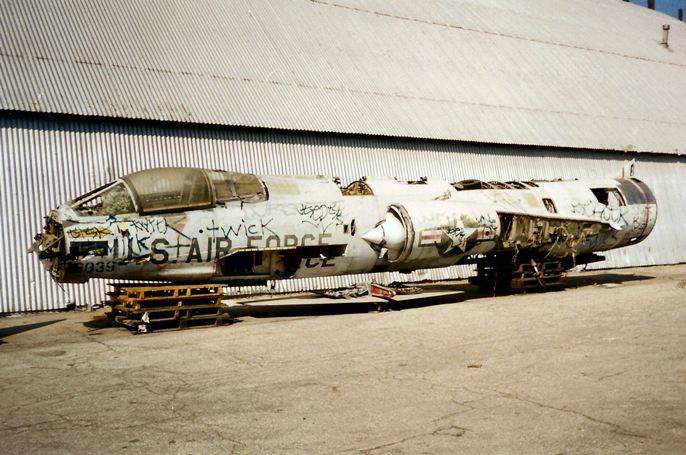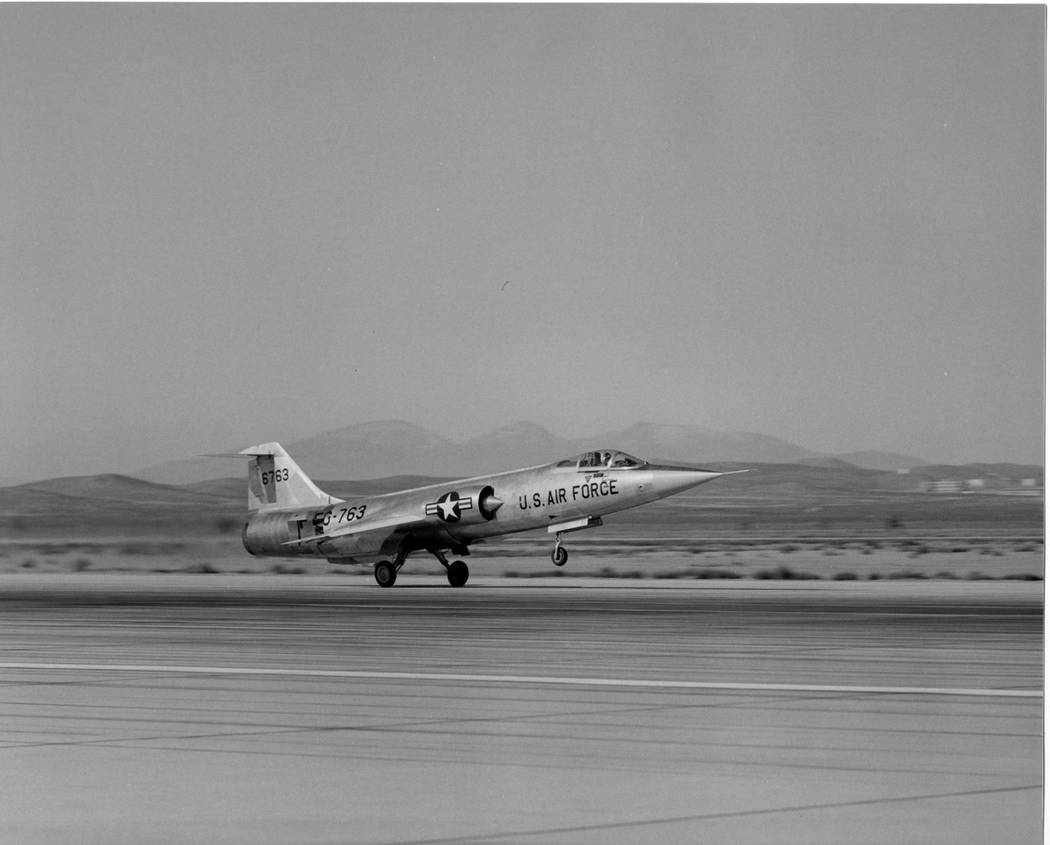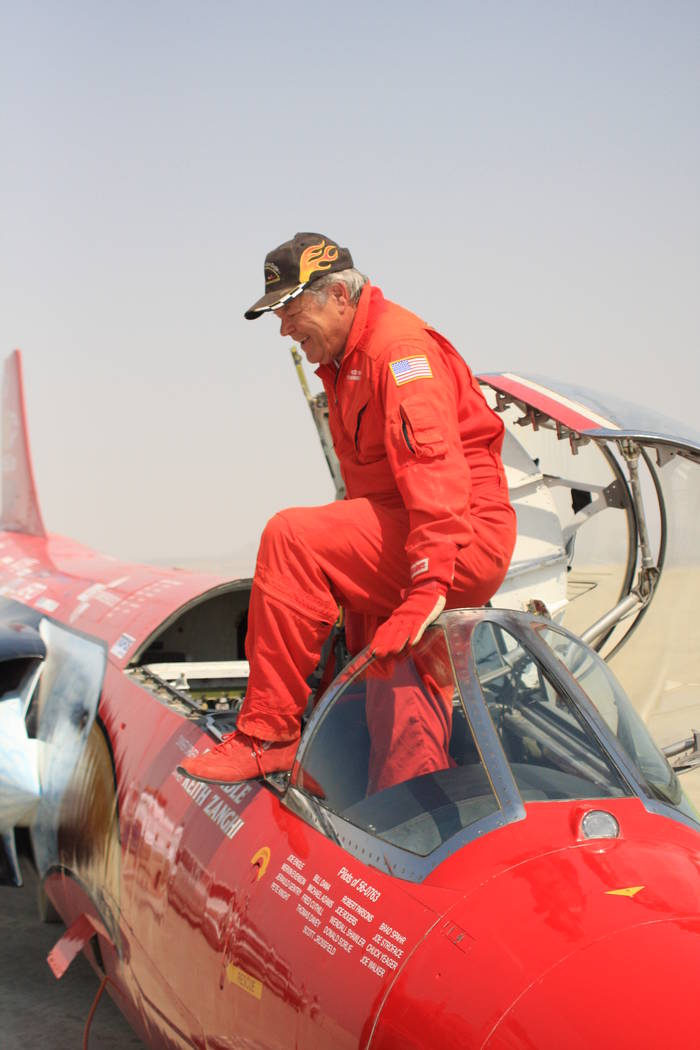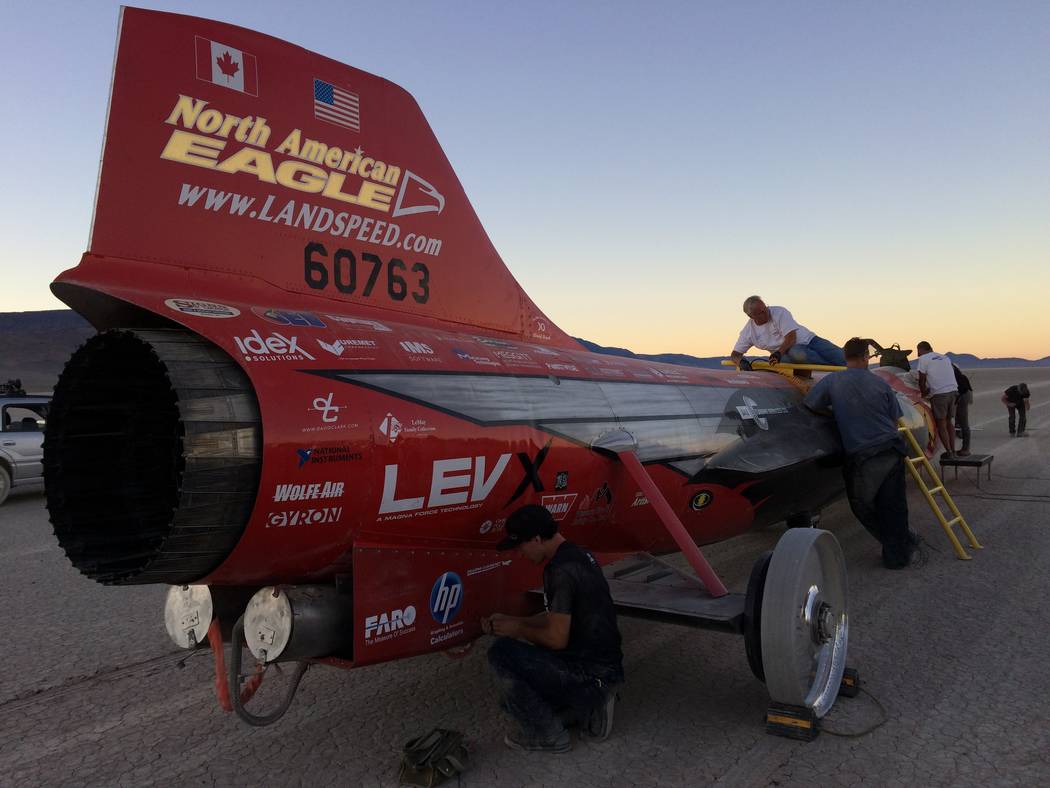Thrill-seeker gets OK to try for land-speed record in Nevada
A 76-year-old thrill-seeker is headed to Nevada next year in hopes of breaking the world land-speed record — and the sound barrier — in a car built from the husk of an old fighter jet.
Now Ed Shadle knows exactly where his run at the record books will take place.
On Monday, the Bureau of Land Management granted Shadle and his Parkland, Washington-based team permission to set up a temporary, 16-mile-long test track on Diamond Valley Playa, a dry lake bed in Eureka County, about 350 miles north of Las Vegas.
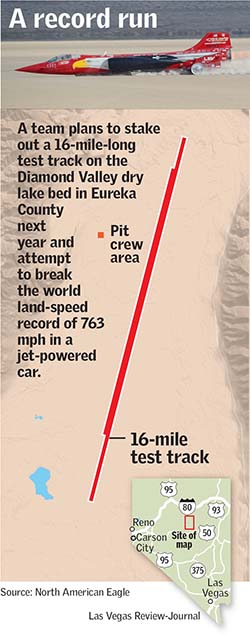
Weather permitting, Shadle said, the team hopes to stake out the track and complete a series of test runs in February, then return in the fall to make history when the dry lake is at its driest.
To set the record, Shadle’s jet-powered North American Eagle will need to top 763 mph and maintain that speed for at least one mile.
“We’ll actually go supersonic,” he said.
‘Like a skating rink’
The car was developed and refined over the past 20 years by an “all-volunteer team, scratching for every dime,” Shadle said.
The fastest the vehicle has gone so far is about 515 mph during a test run two years ago in the Alvord Desert of southeastern Oregon.
Shadle said Alvord was one of the sites they considered for their run at the record, but those other locations in Nevada, Oregon and Utah turned out to be too rough, too short or too busy to accommodate tests at supersonic speeds.
The dry lake in Diamond Valley, about 25 miles north of the town of Eureka, has “a surface like a skating rink” that stretches for miles in every direction, Shadle said. It’s also remote, with only a few ranch roads leading in, so securing the area on test days shouldn’t be a problem.
“Hopefully that’s where we’ll be setting records,” he said.
For the car to operate safely, the lake bed must be clear and dry and the winds calm.
Shadle said driver Jessi Combs will likely be at the controls for the initial speed trials in February, as she seeks to become the fastest woman on land. The current women’s land-speed record of 512.7 mph was set by Kitty O’Neil in the Alvord Desert in 1976.
After that, Shadle and Combs will set their sights on 633 mph, the current world record for a single-engine car, before going after the overall land-speed record.
By comparison, Swedish super-car maker Koenigsegg came to Nevada last month to set the world speed record for a production car with an average speed of 277.9 mph on a closed, 11-mile section of state Route 160 between Las Vegas and Pahrump.
Bones of a fighter jet
Parts of the North American Eagle have actually broken the sound barrier before.
The car is built from the airframe of an F-104 Starfighter jet that once flew out of Edwards Air Force Base in California, where it served as a chase plane for some of the greatest experimental aircraft — and best-known test pilots — in history.
The aircraft was retired in 1971 after 14 years of service. By the time Shadle and company found it in 1998, it was a crumpled, graffiti-covered wreck rusting away in a scrapyard in Maine.
In almost every meaningful way, the resulting race car is like a fighter jet with the wings chopped off, “so you couldn’t take off if you wanted to,” Shadle said.
The car is powered by the same kind of jet engine the F-104 once had, capable in full afterburner of generating more than 42,500 horsepower. The driver sits in a cockpit and pilots the vehicle while strapped into in an ejector seat, though it’s not armed for reasons that are pretty obvious if you think about it.
“If I’m right-side-up, I don’t need to eject, and if I’m on my side or upside-down I don’t want to eject,” Shadle explained.
Not slowing down
Driving at speeds of 500 mph and beyond might seem like risky behavior for a man his age, but Shadle isn’t worried about it.
“Getting old is dangerous too,” he said.
The retired IBM systems analyst still likes to ski, race cars and pilot small airplanes. “I fly on the ground and in the air both,” he said. “I still feel young at heart.”
Just in case, though, Shadle has told his race team to keep an eye on him and speak up if they see any signs that his reflexes are slowing down.
The car rides on wheels made from high-grade aluminum manufactured by a Los Angeles company that specializes in rollercoaster wheels.
The driver brings the car to a stop with parachutes and a unique, non-skid braking system that uses rare-earth magnets to slow the wheels.
“It’s not a bad ride, really,” Shadle said. “The faster you go, the smoother it gets. Once you get up to 400, it’s very smooth.”
Thanks to “Yankee ingenuity” and the aerodynamics of their pencil-shaped design, Shadle said, their jet car can go faster with a single engine than other rocket cars can with two.
The big difference is weight, he said. The North American Eagle weighs nearly 4 tons less than the twin-engine Thrust Supersonic Car that set the current land-speed record in the Black Rock Desert of northwestern Nevada on Oct. 15, 1997.
A race for the record
With Royal Air Force pilot Andy Green at the controls, the British-backed Thurst SSC was the first land vehicle to officially break the sound barrier on its way to the all-time mark, which still stands after 20 years at 763.035 mph.
Shadle hopes his team can bring the record back home to America.
“We’re just a bunch of local hotrodders trying to take on the British Empire,” he said.
They will need to hurry before the competition passes them by.
Already, two teams from Australia have announced plans to break the 763 mark.
But the most formidable challenge will come from British developer Richard Noble and driver and Royal Air Force pilot Andy Green, the same pair responsible for the current land-speed record. They have developed a supersonic car called the Bloodhound SSC that is designed to exceed 1,000 mph.
At about the same time next year that Shadle and company hope to be chasing the speed of sound through Diamond Valley, the Bloodhound team will be in the Kalahari Desert of South Africa, racing to push their record even further out of reach.
Contact Henry Brean at hbrean@reviewjournal.com or 702-383-0350. Follow @RefriedBrean on Twitter.
The North American Eagle by the numbers
56 feet
The length of the jet-powered car from its tail to its nose cone, longer than three average cars packed end to end.
14,000 lbs.
The car weighs more than an African elephant but roughly 7,000 pounds less than the twin-engine rocket car that set the current land-speed record in 1997.
42,500 horsepower
The maximum output at full afterburner of the car's jet engine, which originally powered an F-104 Starfighter supersonic fighter jet.
90 gallons
How much fuel the car burns per minute when running at full power.
$20,000
The cost of each of the car's wheels, which are milled from solid, high-grade aluminum and can endure speeds of more than 800 mph.
763.035 mph
The current land-speed record, set by a British team on Oct. 15, 1997, in Nevada's Black Rock Desert.
North American Eagle's plan
To read the Bureau of Land Management's full review of North American Eagle's plan to challenge the land-speed record, go to https://go.usa.gov/xnQap.




